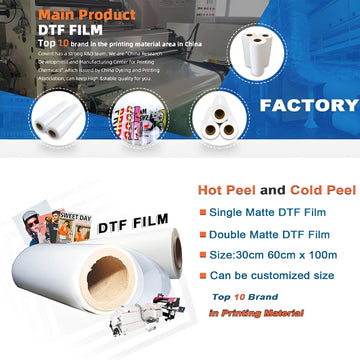TL;DR
In DTF printing, film isn’t just a consumable — it’s your production control point.
Choosing the right film means less downtime, fewer rejects, and faster delivery. Let’s talk numbers, not buzzwords.
🏭 1. Why DTF Film Is a Profit Driver, Not Just a Material
In a busy factory, every failed transfer means:
-
Lost labor time
-
Wasted ink and powder
-
Machine re-cleaning
-
Missed delivery deadlines
Most of these problems come from unstable film coating, curling, or bad peel performance.
Factories that switch to industrial-grade DTF film usually see:
-
✅ Yield rate increase: +15–25%
-
✅ Reprint rate drop: −30–40%
-
✅ Operator speed boost: faster feeding and easier peeling
That’s real, measurable efficiency.
⚙️ 2. Film Stability = Production Stability
A DTF printer runs hours per day — your film must handle:
-
Constant humidity & temperature shifts
-
High powder coating speed
-
Multiple pressure cycles
Only high-stability, double-matte PET film ensures consistent feeding and clean transfer across every batch.
That’s why major print shops now treat film as a precision part, not a random supply.
📈 3. Choosing Film by Your Workflow
| Factory Type | Recommended Film | Core Benefit |
|---|---|---|
| Manual / Small Press Shops | 75 μm warm-peel double-matte | Easy handling, stable edge release |
| Mid-Level Roll Printers | 100 μm cold-peel anti-static | Flatter feeding, uniform curing |
| Automated Lines (Shaker + Oven) | 100 μm hot-peel high-temp | Fast peeling, high throughput |
| Brand OEM Orders | 100 μm low-glare precision film | Consistent color under QA light |
Rule of thumb:
If your output exceeds 50 m/day, you need industrial-grade, anti-static film to protect consistency and yield.
⚡ 4. What “High-Stability” Really Means
Premium DTF films like KungFuDTF’s are engineered for industrial feeding systems, with:
-
📏 True thickness tolerance ±3 μm
-
🌫️ Double-matte anti-static surface → no dust sticking
-
🔥 Uniform coating for sharp color edges
-
🧱 High peel strength window (150–180 °C) — flexible across fabrics
-
🧪 Batch QC tested for adhesion and humidity resistance
These are the same specs demanded by large-volume apparel manufacturers — because performance is predictable, not variable.
🧪 5. Quick Factory Test: 3 Steps to Check Film Quality
Before you sign a supply contract — test like a pro:
-
Feed test: Load 10 m continuous roll. Observe curling and alignment.
-
Print test: Print solid white + fine text. Check ink sharpness.
-
Transfer test: Press 160 °C / 15 s. Peel and check release edge.
If you see static cling, uneven peel, or residue, that supplier is costing you hours — and margins.
🧠 6. ROI: The Math That Matters
| Metric | Standard Film | KungFuDTF Film |
|---|---|---|
| Yield rate | 87% | 98.2% |
| Avg. rework time / 100 m | 45 min | <10 min |
| Ink waste | 8–10% | 2–3% |
| Operator speed | Baseline | +20% faster feeding |
Even saving 1 hour/day equals 22 hours/month — that’s nearly one extra production day without buying another printer.
🏆 Why Factories Choose KungFuDTF Film
-
🧾 Factory-direct supply — no distributors, no price markup
-
⚙️ Double-matte anti-static PET (75 μm / 100 μm)
-
🎨 Hot / Warm / Cold peel options
-
🧪 Tested for Epson I3200, XP600, StarFire heads
-
🔥 Stable peel & zero static across climates
Trusted by OEM garment factories, transfer producers, and overseas distributors in 30+ countries.
More than just a film — it’s the foundation of reliable, profitable DTF production.






